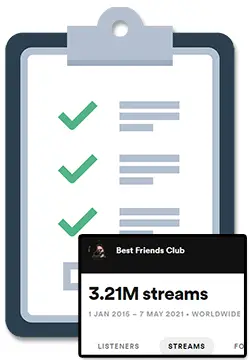Branding is essential for any modern music artist who wants to achieve proper success – but how do you do this without coming across as inauthentic or “corporate”?
By developing your artist brand, you’ll be able to discover more opportunities to make a splash in the music industry, connect with your potential audience, and make the most of your music releases.
In this guide, we’ll go through four simple steps to help you get your music and artist branding right by learning how to identify your audience, identify your brand, communicate your brand, and maintain consistency in your music branding.
These basics of artist branding are straightforward, and you likely already have the foundations of your brand within you and your music.
1. Identifying Your Audience
To effectively build your artist brand, you must first identify your audience. This may seem obvious, but it is a crucial step that cannot be skipped. Knowing your audience will help you understand how to speak to them and connect with them on a deeper level.
To identify your audience, start by narrowing down the genres and styles of music that are similar to yours. Think of other artists who have fan bases that would be interested in your music. From there, you can drill down into demographics such as age groups, nationalities, locations, and even fashion styles.
It is important to remember that your music cannot be specifically for everyone. By trying to appeal to everyone, your music may not be highly suited to anybody in particular. This is not a good place to be and can hinder your success as an artist.
Once you have identified your audience, always keep them in mind when thinking about your brand.
2. Identifying Your Brand Values & Story
The second step is to identify your brand. Your brand should be authentic and true to who you are as an artist. It should reflect your personality, your music, and your artistic vision.
To identify your brand, start by identifying your story, what you’re all about, and what you’re trying to communicate to your audience.
Your brand should be a reflection of everything that you’re about and reflect your character, personality, artist’s vision, and artistic voice.
3. Communicating Your Brand
Once you have identified your audience and brand, the next step is to communicate it effectively.
This includes considering your:
- Aesthetic
- Artwork
- Image
- Color schemes
- Styles
You should also think about your live performances, how you present yourself, and how you behave. All of these aspects should be consistent with your brand and resonate with your potential fan base.
To ensure that you stay on brand, it’s important to write down your ideas and use them as guidelines.
Your image, style, and aesthetic should run through everything you do, including your music, social media, website, and live performances.
4. Consistency In Branding
Consistency is key in branding and it runs through everything that you are doing from your music to your social media, website, live performances, and even how you behave.
To stay on brand, you need to be consistent and stick to it for a period of time, at least for an entire set of releases and touring. This helps you build a fan base around your brand.
It is fine to change and develop your brand over a long period of time, but you need to let your brand do its thing and become a part of what you’re about.





